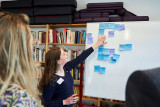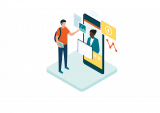Amsterdam University of Applied Sciences

Program Partner Amsterdam Smart City
Activity
- 232Updates
- 0Thumbs up
- 46Comments
Demoday #23: Mobility Injustices and the creative mind.

In a world where moving yourself from point A to point B is becoming much more crucial than ever, there are people out there who cannot experience such a luxury at the flick of a wrist, or perhaps the clack of an ankle? It is hard to imagine sometimes, but there are those who cannot move around as easily as others; be it because of financial, physical, vehicular, or other reasons. A community that can go about as they please without any issues is a happy community that is beneficial to society – For a collective of governments and businesses it is in their best interests to ensure citizens can experience freedom and liberty in their mobility. The question of how to achieve this freedom in mobility and how to deter against injustices regarding mobility remains a hot topic, however. On behalf of Provincie Noord Holland and in collaboration with Amsterdam Smart City and Amsterdam Centre of Expertise, a group of graduating students tackled this topic on the latest Demoday of 2024.
Starting the voyage : What are mobility injustices?
A value workshop led by Jackie Ippel and Jade Salomons engaged the participants in a fun, creative wave of brain-crackling activities. Participants were presented with a question of whether they knew what mobility injustices, or as we call it in Dutch “Mobiliteits Armoede”, was. An explanation of which followed suit soon after. Mobility Injustices, as described by the KiM organization, explains the inability or difficulties people experience in terms of reaching activity locations due to inadequate transport options, combined with socio-economic and spatial conditions in which people find themselves. As a result, they are often hindered in their participation in social life, which negatively affects their quality of life.
It is important to think about the definition of what exactly mobility injustices entail, as it helps us find a better understanding in finding a creative series of solutions that will solve this complex jigsaw puzzle.
Like a ball of yarn : unraveling theorems.
In order to stimulate the brain of each participant and to get the blood pumping through their legs, each participant was asked to stand in the middle of the room. As was once quoted in the horror thriller Saw; “Wanna play a game?”. Participants were presented with a series of theorems in which they had to make a choice that’d question their liberal thoughts; either stand on one side of the room for one answer or on the other side for the other – No in-betweens. Being forced to make ultimatums proved to be both challenging for the participants yet fun, as it was met with bountiful heaps of enthusiasm. In the first theorem, participants were presented with a question of whether or not mobility should be a fundamental right for each and every citizen. While agreed one did not, but can their minds be changed? A flurry of other theorems were presented, each of which dove deeper into the depths of dilemmas one may encounter when attempting to solve the puzzle of mobility inequality. Like who is more important, those who have low incomes or those who suffer from physical and mental disabilities which hinder their day-to-day lives? Brief discussions flowed forth after each and every theorem, after each voting round, reasons were given as to why one can choose one over the other. After which another second voting session followed. Perhaps new insights would change one’s opinion on the subject? It actually did once or twice! Such is the power of dialogue.
Embarking into the abyss : Worst Idea Possible.
“How ba-a-a-ad can I be? I’m just doing what comes naturally-“ -such were the words Onceler sung in Dr. Seuss’s ‘The Lorax’. While people do not like the idea of being bad or thinking of bad ideas sometimes this way of thinking can actually bring plentiful new insights never thought of before. The group split itself in two, each of which under the guidance of either Jackie Ippel or Jade Salomons. Participants were asked to come with their most horrid, ludicrous ideas that’d actually make mobility injustices worse. After which they had to decide what element made this a bad idea. Example, if public transport were to be described, the element that’d make the idea bad would be less alternatives for traveling. The final and third part of this exercise required something rather unique however. Does your mind already wonder what? Well, it’s quite simple really, now participants had to come up with what would be the opposite of their bad idea! So what would their idea be in reverse, an actual solution to the problem they created. If your bad solution was to make everything only scannable by QR-codes its reverse solution would be… using solely physical text! For a solid 20 minutes participants racked their heads and discussed until their times were down to only 5 minutes left. The last of those minutes left were spent discussing and laughing about their ideas – A method met with confusion at first was appreciated with loads of enthusiasm by the end where only time was the fun killer.
A creative view found in madness: Crazy Eight.
The creativity cannot just end after one session. Holding the thought of the previous session, participants were asked to gather in a circle around a table. With each given a paper and asked to fold it so that 8 separate square spaces would form on the sheet the Crazy Eight exercise was explained. Participants were asked to draw their solution one of their 8 square. For each drawing they had a minute per square, a total of 8 minutes until all were filled. Of course with so little time there was little room for thinking, imagination had to pull the cart here, which led to both silly and unique drawings. The longer the session went on the more difficult it became – the participants were truly pushed to their creative limits. A well-trained eye could even notice how some participants still tried to finish their previous drawing before moving onto the next despite the time. You could feel the atmosphere in the room shift to a hectic, almost crazy aura, thus doing its name of ‘Crazy Eight’ truly justice.
At the end of the session it was only natural that people presented their top 3 drawings. One after another each participant proudly showed off their creative drawings like a trophy to the rest of the group. Turns out, despite not communicating with one another during the drawing sessions there were lots of similarities in the elements used in each drawing. The bus, the civil servant, and the elderly were commonly used elements seen back in almost everyone’s drawing. Via these sources of inspiration it became clear just where the solutions may lie.
An journey’s end : Results.
At the end of the session we didn’t just start talking about what we had done. No, instead we At the end of the session, we didn’t just start talking about what we had done. No, instead we went back and looked at the very first theorem everyone was presented with; “Should mobility be a fundamental right for each and every citizen?”. Last time everyone answered all but one was in favor of this theorem, now participants were asked to revise their statement and see if they still agreed with what they said at the beginning. As said before, dialogue can change the outlook we have on the world and so someone did change their stance – The one person that disagreed with the theorem now actually agreed that mobility should be a fundamental right. A full 100% score! Only after this a talk about what we had done started. Opinions were asked and each participant shared the emotion they had experienced during this work session and to leave it behind on a post-it.
· Fun and insightful: The gamification of thinking is taking the design world by storm, and on this Demoday, it has proven that this form of design thinking can not only be effective in bringing brand new insights but also can be fun.
· Enthusiasm: What started off with an iffy approach ended with tons of enthusiasm. Idea generating doesn’t just have to be sitting at a table and talking in your own bubble; it can become so much more effective when the mood is changed from serious and gloomy to frivolous and enthusiastic..
· Creativity: A creative way of thinking actually helps in generating ideas. Using playful thinking such as considering a bad idea first and then the opposite helps find solutions to problems in a much more efficient way.
During this Demoday, we as a group of graduating students got to know the thought process behind those who work within the field of mobility. While we hope that we brought them plenty of insights and, above all, a fun day, it is sufficient to say that we too learned an abundance of information. The insights made during the Demoday will be used by us in writing our final report for the Provincie Noord Holland regarding a detailed consult on how to improve the mobility of the citizens of the province of Noord-Holland and how to tackle the injustices surrounding mobility. Demoday’s are fun and can inspire even the most closed-minded people. If we could, we would do it all over again. And, if you are still on the fence about joining a Demoday, then I hope that column will ignite that curiosity.
Symposium Smart Education

Op vrijdag 7 juni 2024 organiseert het Smart Education Lab van de Hogeschool van Amsterdam een symposium dat in het teken staat van digitale middelen voor het onderwijs.
Vijf jaar geleden is binnen de Faculteit Onderwijs en Opvoeding, het Smart Education programma opgezet. Dit programma onderzoekt hoe AI en andere digitale technologieën het onderwijs kunnen verbeteren, door verschillende projecten en netwerkactiviteiten, zowel binnen het eigen onderwijs als samenwerkingen met partners.
Tijdens dit symposium delen we de onderzoekresultaten, verzorgen wij verschillende workshops en kun je kennismaken met de mensen die er aan werken.
Voor de keynote hebben we een intrigerende gastspreker in huis gehaald. Prof. dr. Frank van Harmelen is een internationaal toonaangevende wetenschapper op het gebied van AI. Met zijn jarenlange ervaring neemt hij ons mee in de brede wereld van deze technologie.
𝗧𝗵𝗲 𝗖𝗮𝗺𝗲𝗿𝗮 𝗖𝗮𝗿 𝗙𝗮𝗶𝗿 / 𝗧𝗵𝗲 𝗙𝗮𝗶𝗿 𝗖𝗮𝗺𝗲𝗿𝗮 𝗖𝗮𝗿 experiment

𝗧𝗵𝗲 𝗖𝗮𝗺𝗲𝗿𝗮 𝗖𝗮𝗿 𝗙𝗮𝗶𝗿 / 𝗧𝗵𝗲 𝗙𝗮𝗶𝗿 𝗖𝗮𝗺𝗲𝗿𝗮 𝗖𝗮𝗿
This experiment created by Tessa Steenkamp, questions what the camera car in your city sees, that you can’t see? Come explore the journey its data travel, and how they are used. Which functions do you think are a good idea – and where do you think is the limit? More info here
The experiment is organized by the HvA 𝙃𝙪𝙢𝙖𝙣 𝙑𝙖𝙡𝙪𝙚𝙨 𝙛𝙤𝙧 𝙎𝙢𝙖𝙧𝙩𝙚𝙧 𝘾𝙞𝙩𝙞𝙚𝙨 research team. Human Values for Smarter Cities is a 4 year research project on how to make smart city technology understandable and contestable through civic participation.
The experiment is hosted by 𝗧𝗛/𝗡𝗚𝗦 𝟮𝟬𝟮𝟯 on 𝗗𝗲𝗰 𝟭𝟱𝘁𝗵 at Het Nieuwe Instituut. This year's theme: ‘𝗨𝗻/𝗻𝘁𝗲𝗻𝗱𝗲𝗱 𝗰𝗼𝗻𝘀𝗲𝗾𝘂𝗲𝗻𝗰𝗲𝘀’, explores and promotes the development of fair, responsible, and human-centric technologies for the #IoT and beyond. The event is organized by ThingsCon and powered by CLICKNL.
𝗥𝗲𝗴𝗶𝘀𝘁𝗲𝗿 here 𝗳𝗼𝗿 𝗧𝗛/𝗡𝗚𝗦 𝟮𝟬𝟮𝟯 𝗮𝗻𝗱 𝘄𝗲 𝗹𝗼𝗼𝗸 𝗳𝗼𝗿𝘄𝗮𝗿𝗱 𝘁𝗼 𝘀𝗲𝗲𝗶𝗻𝗴 𝘆𝗼𝘂 𝘁𝗵𝗲𝗿𝗲!
𝗥𝗲𝘀𝗽𝗼𝗻𝘀𝗶𝗯𝗹𝗲 𝗨𝗿𝗯𝗮𝗻 𝗦𝗲𝗻𝘀𝗶𝗻𝗴 workshop

𝗥𝗲𝘀𝗽𝗼𝗻𝘀𝗶𝗯𝗹𝗲 𝗨𝗿𝗯𝗮𝗻 𝗦𝗲𝗻𝘀𝗶𝗻𝗴
In this workshop, Tom van Arman will guide you through some concrete citizen-by-design applications, toolkits and techniques to keep your smart city projects safe, insightful and inclusive to all. In this hands-on workshop, we will examine the Scan-Car. What is its purpose? What what does it do today? What can it do tomorrow? Teams will collaborate and speculate how the Scan Car can fit a citizen-centric future city. More info here
The workshop is organized by the HvA 𝙃𝙪𝙢𝙖𝙣 𝙑𝙖𝙡𝙪𝙚𝙨 𝙛𝙤𝙧 𝙎𝙢𝙖𝙧𝙩𝙚𝙧 𝘾𝙞𝙩𝙞𝙚𝙨 research team. Human Values for Smarter Cities is a 4 year research project on how to make smart city technology understandable and contestable through civic participation.
The workshop is hosted by 𝗧𝗛/𝗡𝗚𝗦 𝟮𝟬𝟮𝟯 on 𝗗𝗲𝗰 𝟭𝟱𝘁𝗵 at Het Nieuwe Instituut. This year's theme: ‘𝗨𝗻/𝗻𝘁𝗲𝗻𝗱𝗲𝗱 𝗰𝗼𝗻𝘀𝗲𝗾𝘂𝗲𝗻𝗰𝗲𝘀’, explores and promotes the development of fair, responsible, and human-centric technologies for the #IoT and beyond. The event is organized by ThingsCon and powered by CLICKNL.
𝗥𝗲𝗴𝗶𝘀𝘁𝗲𝗿 here 𝗳𝗼𝗿 𝗧𝗛/𝗡𝗚𝗦 𝟮𝟬𝟮𝟯 𝗮𝗻𝗱 𝘄𝗲 𝗹𝗼𝗼𝗸 𝗳𝗼𝗿𝘄𝗮𝗿𝗱 𝘁𝗼 𝘀𝗲𝗲𝗶𝗻𝗴 𝘆𝗼𝘂 𝘁𝗵𝗲𝗿𝗲!
𝗥𝗲𝗽𝗮𝗶𝗿𝗶𝗻𝗴 𝘂𝗻𝗶𝗻𝘁𝗲𝗻𝗱𝗲𝗱/𝘂𝗻𝘄𝗮𝗻𝘁𝗲𝗱 𝗰𝗼𝗻𝘀𝗲𝗾𝘂𝗲𝗻𝗰𝗲𝘀 𝗼𝗳 𝗲𝘅𝗶𝘀𝘁𝗶𝗻𝗴 𝗦𝗺𝗮𝗿𝘁 𝗖𝗶𝘁𝘆 𝗧𝗲𝗰𝗵𝗻𝗼𝗹𝗼𝗴𝗶𝗲𝘀

𝗥𝗲𝗽𝗮𝗶𝗿𝗶𝗻𝗴 𝘂𝗻𝗶𝗻𝘁𝗲𝗻𝗱𝗲𝗱/𝘂𝗻𝘄𝗮𝗻𝘁𝗲𝗱 𝗰𝗼𝗻𝘀𝗲𝗾𝘂𝗲𝗻𝗰𝗲𝘀 𝗼𝗳 𝗲𝘅𝗶𝘀𝘁𝗶𝗻𝗴 𝗦𝗺𝗮𝗿𝘁 𝗖𝗶𝘁𝘆 𝗧𝗲𝗰𝗵𝗻𝗼𝗹𝗼𝗴𝗶𝗲𝘀
In this workshop we will look at unwanted consequences, based on two existing urban technologies: a parking scan car service and an online reporting platform for local issues. We will use a canvas and our imagination to work on recommendations to repair the existing systems and/ or structures where these consequences originated. Hosted by Mike de Kreek
More info here
The workshop is organized by the HvA 𝙃𝙪𝙢𝙖𝙣 𝙑𝙖𝙡𝙪𝙚𝙨 𝙛𝙤𝙧 𝙎𝙢𝙖𝙧𝙩𝙚𝙧 𝘾𝙞𝙩𝙞𝙚𝙨 research team. Human Values for Smarter Cities is a 4 year research project on how to make smart city technology understandable and contestable through civic participation.
The workshop is hosted by 𝗧𝗛/𝗡𝗚𝗦 𝟮𝟬𝟮𝟯 on 𝗗𝗲𝗰 𝟭𝟱𝘁𝗵 at Het Nieuwe Instituut. This year's theme: ‘𝗨𝗻/𝗻𝘁𝗲𝗻𝗱𝗲𝗱 𝗰𝗼𝗻𝘀𝗲𝗾𝘂𝗲𝗻𝗰𝗲𝘀’, explores and promotes the development of fair, responsible, and human-centric technologies for the #IoT and beyond. The event is organized by ThingsCon and powered by CLICKNL.
𝗥𝗲𝗴𝗶𝘀𝘁𝗲𝗿 here 𝗳𝗼𝗿 𝗧𝗛/𝗡𝗚𝗦 𝟮𝟬𝟮𝟯 𝗮𝗻𝗱 𝘄𝗲 𝗹𝗼𝗼𝗸 𝗳𝗼𝗿𝘄𝗮𝗿𝗱 𝘁𝗼 𝘀𝗲𝗲𝗶𝗻𝗴 𝘆𝗼𝘂 𝘁𝗵𝗲𝗿𝗲!
Just.City.2023

KOM NAAR JUST.CITY.AMSTERDAM.2023
Amsterdam is al 750 jaar in beweging. De ontwikkelingen van de afgelopen jaren maken het een stad waarin niet voor iedereen plek is. Basisvoorzieningen zoals wonen, onderwijs, zorg, voedsel, de publieke ruimte en een leefbaar klimaat staan bijvoorbeeld steeds meer onder druk. We merken allemaal dat er zaken niet rechtvaardig zijn en daar willen wij, samen met jou, verandering in brengen.
Vanaf 16 november voert het Centre of Expertise Urban Governance and Social Innovation daarom officieel de naam Centre of Expertise Rechtvaardige Stad. Op die datum organiseren wij als lancering Just.City.Amsterdam.2023; een middag vol workshops, lezingen, gesprekken en persoonlijke ontmoetingen. Tijdens deze middag in Ru Paré Community willen we elkaar inspireren en aanzetten tot manieren om naar een rechtvaardige stad te kijken en er samen aan te werken. Jij bent van harte welkom!
We hebben schrijvers, dichters, onderzoekers, ondernemers, studenten, bestuurders en buurtorganisaties uit de stad gevraagd om een bijdrage te leveren aan ons programma. Met onder andere: Gökhan Aksoy, Abdelkader Benali, Joris Lechêne, Ria Braaf-Fränkel, Lucia Kula, Roberto Rocco, Arnt Mein.
Via onderstaande knop vind je meer informatie over de lancering en het aanmelden.
Bijeenkomst eindresultaten onderzoek Boundary Spanners in actie

Werk jij aan grootstedelijke vraagstukken en kom je daarbij steeds grenzen tegen tussen verschillende domeinen? Ben jij op zoek naar manieren om effectiever met die grenzen om te gaan? Kom dan op 28 september naar de slotbijeenkomst van het onderzoek ‘Boundary spanners in actie’.
Tijdens deze unieke en creatieve middag gaan we aan de slag met nieuwe inzichten uit dit onderzoek en ontdek je een nieuw handelingsrepertoire om je effectiviteit als boundary spanner te vergroten.
In het netwerk van Amsterdam Smart City werken ook veel mensen die deze rol van Boundary spanner hebben, in het vormgeven van projecten en intiatieven en tussen de partners. Boundary spanners zijn essentieel bij het overbruggen van domeingrenzen bij grootstedelijke vraagstukken zoals leefbaarheid, veiligheid, gebiedsontwikkeling, armoede enzovoort. Zij helpen om de verschillen te overbruggen die samenwerking moeilijk maken, zoals verschillen in sociale waarden en omgangsvormen die personen of groepen aanhangen, taal- en procedureverschillen tussen expertises, afdelingen en organisaties, of de effecten van de budgettaire inrichting op de machtsverhoudingen.
De afgelopen twee jaar volgden we tijdens het onderzoek ‘Boundary spanners in actie’ vijf verschillende project- en programmateams van professionals die in Amsterdam en Den Haag aan grootstedelijke vraagstukken werken. In deze slotbijeenkomst delen we de uitkomsten van dit onderzoek in de vorm van nieuwe inzichten en nieuwe handelingsmogelijkheden voor de boundary spanners, waarmee zij (nog) beter in staat zijn om grenzen te overbruggen bij het werken aan grootstedelijke vraagstukken.
Stay up to date
Get notified about new updates, opportunities or events that match your interests.



